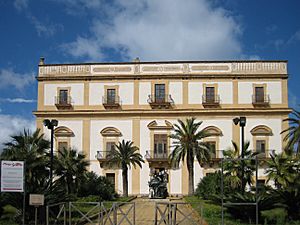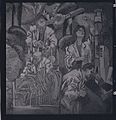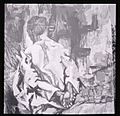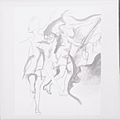Renato Guttuso facts for kids
Quick facts for kids
Renato Guttuso
|
|
|---|---|
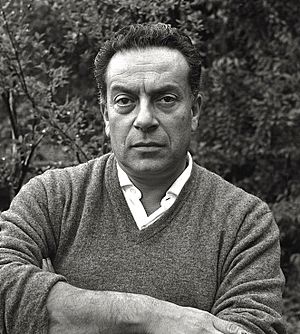 |
|
| Member of the Senate | |
| In office 5 July 1976 – 11 July 1983 |
|
| Personal details | |
| Born |
Aldo Renato Guttuso
26 December 1911 Bagheria, Italy |
| Died | 18 January 1987 (aged 75) Rome, Italy |
| Political party | Italian Communist Party |
| Alma mater | University of Palermo |
| Occupation | Painter |
Renato Guttuso (born December 26, 1911 – died January 18, 1987) was a famous Italian painter and politician. He is known for his powerful paintings that often showed real life and important social issues. Some of his most famous works are Flight from Etna (1938–39), Crucifixion (1941), and La Vucciria (1974).
Guttuso also created designs for plays, including sets and costumes. He illustrated books too, like Italian Food by Elizabeth David. He was strongly against Fascism, a political movement. His art often showed landscapes and commented on society, using a style inspired by Expressionism and the bright light of his home country, Italy.
Contents
Renato Guttuso's Life and Art
Early Life and Artistic Beginnings
Renato Guttuso was born in Bagheria, a town near Palermo in Sicily, Italy. From 1937, he mostly lived and worked in Rome. When he was young, he joined a university group. However, he later became strongly against fascism and became an atheist.
In 1940, he joined the Italian Communist Party, which was not allowed at the time. From 1943, he left Rome to join the resistance fighters who were fighting against the Fascists. He also spoke out against the Sicilian Mafia. In 1972, Guttuso received the Lenin Peace Prize for his work. In 1976, he was chosen to be a member of the Italian Senate, representing Sicily.
Childhood and Early Influences
Renato Guttuso's father, Gioacchino Guttuso, was a land surveyor and enjoyed painting with watercolors. Renato started signing and dating his own artworks when he was just thirteen years old. He lived near old villas like Valguarnera and Palagonia. These grand, but decaying, buildings later appeared in his paintings.
In Palermo and Bagheria, Guttuso saw many 18th-century noble villas falling apart. His family also faced tough times because Fascists and religious leaders were against his father.
Guttuso went to high school and then to the University of Palermo. There, he learned about European art styles. He was inspired by artists like Gustave Courbet, Van Gogh, and Picasso. In the early 1930s, Guttuso often visited the studio of Pippo Rizzo, a well-known futuristic painter. His early works helped him travel to Milan and other parts of Europe.
As Guttuso's art style became more expressive, he painted many scenes of nature. He painted flowers, lemon trees, and olive trees. These paintings showed a mix of myth and island life. In 1931, he showed his work at the Quadriennale di Roma expo. He was part of a group of six Sicilian painters who were praised by critics. Back in Palermo, Guttuso opened his own art studio. He formed a group called Gruppo dei Quattro (The Group of Four) with other artists.
Art for Change: Social Art and Anti-Fascism
Guttuso joined an art movement called "Corrente." This group believed in freedom and open ideas. They were against the official culture of the time. They took a strong anti-fascist stand, especially during the Spanish Civil War.
While in Milan for three years, Guttuso was part of Corrente di Vita. Here, he developed his "social" art. This meant his paintings showed his strong moral and political beliefs. Examples include Fucilazione in Campagna (1938), which honored the writer Federico García Lorca, and Escape from Etna.
When he moved to Rome, Guttuso opened a studio in Via Margutta. His friend Marino Mazzacurati nicknamed him "Unbridled" because of his lively personality. He lived near other important artists like Mario Mafai and Corrado Cagli. He also stayed in touch with artists from Milan like Giacomo Manzù.
His painting "Crocifissione" ("Crucifixion") is one of his most famous works. At the time, religious leaders criticized it, calling Guttuso a "pictor diabolicus" (a "devilish painter"). Fascists also spoke out against it. They said it showed the horrors of war using a religious theme. Guttuso wrote in his diary that the painting was "the symbol of all those who endure insults, jail, torture for their ideas." He also explained that he wanted to paint Christ's suffering as a modern scene. It was a symbol for anyone who faced pain for their beliefs during wartime.
Guttuso continued to work during World War II. He painted landscapes of the Gulf of Palermo. He also created a collection of drawings called Massacri (Massacres). These drawings secretly showed massacres, like the Fosse Ardeatine.
In 1945, Guttuso and other artists started the "Fronte Nuovo delle Arti" (New Arts Front). This group helped artists who had been limited by fascist rule. During this time, he also met and became friends with Pablo Picasso. Their friendship lasted until Picasso's death in 1973. Guttuso's art during this period often focused on social and political themes. He painted the daily lives of peasants and working-class people. In 1950, he won the World Council of Peace Prize in Warsaw. He later received the Lenin Peace Prize in 1972.
Later Works and Legacy
In 1938, Guttuso met Mimise Dotti, and they married in 1956. The famous poet Pablo Neruda was a witness at their wedding. Mimise became his trusted friend and often posed for his paintings. After Italy was freed from Nazi Germans, he finished "Muratori in riposo" ("Workers resting") in 1945. This artwork, made with ink and watercolor, symbolized rebirth. The writer Pier Paolo Pasolini wrote a poem about it in 1962:
The shapes of ten workers
emerge white over white masonry
the noon is that of the summer.
But the humiliated flesh
projects a shadow; is the disarranged order
of the white colors, that is faithfully followed
by the black ones. The noon is a peaceful one.
In the years that followed, Guttuso painted "Peasant Who Hoes" (1947) and "Peasants of Sicily" (1951). In these works, his painting style became very clear and simple. Guttuso said these were early drawings for "Occupation of uncultivated lands of Sicily." This painting was shown at the Venice Biennale in 1950. He felt these works connected to his deepest inspirations. He said they reminded him of his childhood, his people, and his homeland in Sicily. He felt a strong connection to Sicilian peasants, seeing them as very important in Italy's history.
In 1950, Guttuso contributed to the Verzocchi collection in Forlì. He sent a self-portrait and works like "Sicilian labourer" and "Bagheria on the Gulf of Palermo." He also painted "Battle of the Bridge of the Admiral," showing his grandfather Ciro as a Garibaldine soldier. Guttuso also created a series of paintings about peasants fighting for land. He painted scenes of sulfur miners and landscapes with cacti. He also painted portraits of important cultural figures.
In 1961, Guttuso created a series of colorful drawings inspired by Dante's famous work, Inferno. These were published in 1970 as Il Dante di Guttuso. He showed the characters of Hell as examples from human history. This showed how talented he was. In the late 1960s and 1970s, he painted many works focusing on women. This theme became very important in his art and life. "Donne stanze paesaggi, oggetti" (1967) was followed by portraits of Marta Marzotto, who was his favorite model for many years.
His most famous painting about Palermo is "Vucciria." This painting shows Palermo's market with a raw and realistic style. It captures one of the many spirits of the Sicilian city.
Mimise Dotti-Guttuso, his wife, passed away on October 6, 1986. Renato Guttuso died soon after her, on January 18, 1987, in Rome, at the age of 75. He had lung cancer. He gave many of his artworks to his hometown of Bagheria. These works are now displayed in the museum at the Villa Cattolica.
Images for kids
See also
 In Spanish: Renato Guttuso para niños
In Spanish: Renato Guttuso para niños


